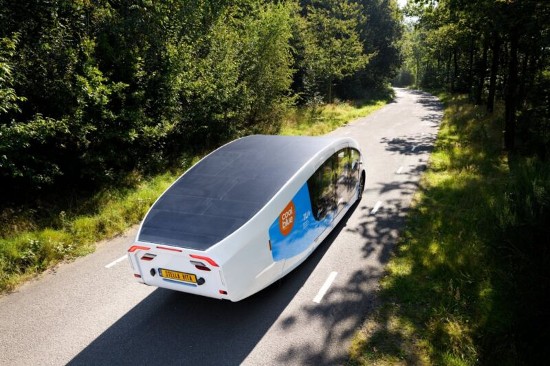In the Netherlands, students at the Eindhoven University of Technology, have built a solar-powered tiny house on wheels. Built by 22 students in the Solar Team Eindhoven, the house on wheels will get its first long-duration test on a forthcoming trip to Southern Spain.
This is the second solar vehicle the Eindhoven group has invented. The first was a family car called Stella Lux. This one has been given the name Stella Vita. As you can see from the picture above, the vehicle has aerodynamic lines. On a sunny day, its range is 730 kilometres (450 miles) if you don’t use any of its many amenities inside.
When parked the roof slides up and two solar panel additions extend out on either side increasing the solar capacity to 17.5 square metres (188 square feet), not only providing power, but also a bit of shade. You can also plug the vehicle into a charging station in the event of a cloudy day. To fill the battery storage to capacity takes the solar panels about two to three days.
The interior comes with a bed, fridge, toilet, couch, and cooktop. There are charge ports for smartphones. tablets, and laptop computers. The onboard information system keeps the driver apprised of his or her energy use.
To demonstrate the technology the team is sending a driver south on a 3,000-kilometre trek that will last for four weeks with stops at universities and events along the way to show off.
The pursuit of solar-powered vehicles is ongoing and not just confined to university and polytechnical institute campuses. The limitations have always been recharging rates and range. But integrating photovoltaics is becoming more attractive to mainstream vehicle manufacturers and new startups. A number of companies are developing prototypes. These include startups like Squad Mobility, Stella Ersa, Aptera Motors, Atlis Motor Vehicles, Fisker, Light Year, and Sono. And then there are the better-known mainstream contenders like Hyundai, Toyota, and Tesla.
Hyundai’s solar car uses a roof system of solar cells to generate electricity. But it is a hybrid so the solar aspect plays only a supporting role.
Toyota’s entry is a Prius with 34% of its surfaces covered by 0.03 millimetre-thick cells. Compared to the average of 20% for other solar vehicle contenders, Toyota claims that its car will be able to continuously run without ever requiring a plug-in recharge.
Tesla is building its all-electric battery-powered Cybertruck with a solar panel option that can extend operational range each day by up to 24 kilometres (15 miles).
So Stella Vita is far from being alone in carving out a place in the solar car race. According to members of the Solar Team Eindhoven, they expect vehicles powered by the sun to be a reality before the end of the decade. But, for now, if you are in Southern Spain in the next few weeks you may be able to see what the future will bring, a self-sustaining tiny solar house on wheels.
















